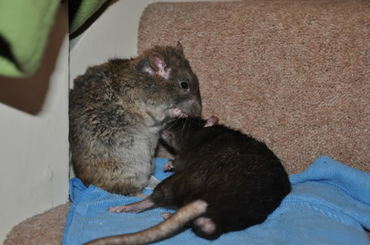Rats interacting with other Rats
Rat social structure
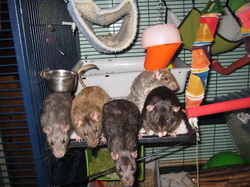
Rats naturally live in complex social groups, this contains a set hierarchy where a rat knows their place. A rat with a stable hierarchy is generally a happy one, problems usually occur when the social structure changes for some reason, whether this be the addition of new rats, illness, a surge in hormones triggering one of the rats to want to change it’s status or some other environmental disruption. Understanding your rats position in there group can help you understand more about there behaviour and better understand some of the interactions witnessed. Hierarchy’s are much easier to observe in larger groups group sizes over 4 generally giving a much richer picture of social interaction. The terms, Alpha, Beta and Zeta rats are often used in scientific research, as far as I am aware gamma rats are my own invention to split the normally broader beta group into those with an interest in cage politics and those without.
The Alpha
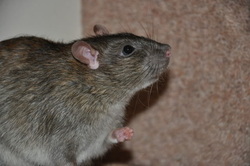
Loki - one of the best Alpha's I've owned
This is the most important position in a rat group, the alpha rat generally has the biggest effect on how rats go about there daily life as well as how the group as a whole functions and feels. The Alpha is the dominant rat of the group, often also the strongest and most confident rat. This is partially due to their ability to win fights and in buck groups partially to do with the presence of an Alpha rat in a group possibly stunting the growth of other bucks. Occasionally a small rat with sufficient attitude may become alpha of a cage, more due to laziness and lack of drive in the others than anything else. A good Alpha is a blessing on the cage, they are also often hard to spot. A good Alpha will not often fight with their subordinates, though they may step in to settle disputes and they will generally win most of the battles they take part in. They will generally rule gently and from afar, acting much like a normal rat most of the time. Even in the presence of sudden changes in the hierarchy, such as the addition of a new rat, the good Alpha will normally take in his stride, with only the minimum necessary dominating, assuming the incomer submits.
A poor Alpha is one that takes their position to extremes, they will often spend much of their time harassing their subordinates and may become territorial towards rats and humans alike. This can range from outright aggressive behaviour to persistent bullying of one or two rats in the cage. It is often triggered by an excess of hormones (more common in bucks than does) and can often be resolved by neutering the offending party. A cage containing a bad Alpha is rarely settled, the subordinates often take part in more fights themselves as the whole group becomes on edge. Often the only way to resolve this is to shift the balance of power, though sometimes if caused by a testosterone surge it may settle down again over time. It can be very hard to introduce new rats into a group led by a bad Alpha. A bad Alpha may also benefit from more dominant handling by the owner as this helps reassure them that they can relax and not be in charge in some situations.
Alpha rats can experience stress from chance more profoundly than other rats. You may notice your Alpha show signs of behavioural changes, even scumming to illnesses or general ill health after a significant disruption to their world. This is due to there greater responsability, they feel the need to protect and maintain stability for their pack. In times of change and upheaval, look to your Alpha first to judge your general group.
A poor Alpha is one that takes their position to extremes, they will often spend much of their time harassing their subordinates and may become territorial towards rats and humans alike. This can range from outright aggressive behaviour to persistent bullying of one or two rats in the cage. It is often triggered by an excess of hormones (more common in bucks than does) and can often be resolved by neutering the offending party. A cage containing a bad Alpha is rarely settled, the subordinates often take part in more fights themselves as the whole group becomes on edge. Often the only way to resolve this is to shift the balance of power, though sometimes if caused by a testosterone surge it may settle down again over time. It can be very hard to introduce new rats into a group led by a bad Alpha. A bad Alpha may also benefit from more dominant handling by the owner as this helps reassure them that they can relax and not be in charge in some situations.
Alpha rats can experience stress from chance more profoundly than other rats. You may notice your Alpha show signs of behavioural changes, even scumming to illnesses or general ill health after a significant disruption to their world. This is due to there greater responsability, they feel the need to protect and maintain stability for their pack. In times of change and upheaval, look to your Alpha first to judge your general group.
The Beta
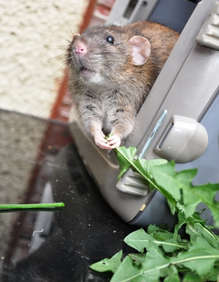
Isamu - the Beta of his group under Loki,
A beta is typically the number 2 rat, or several rats in the group who remain dominant but are submissive to the Alpha. To fully observe beta behaviour you need a group over 3-4 large with the right range of characters. This may lead to more than one beta in the cage and adds an extra dimension to cage politics. Within the beta group there will be a structured hierarchy, with the top beta acting as the alpha’s number 2. Often the beta is the more actively dominating rat in the cage so can often be mistaken for the alpha. This is also the rat who will often take over should something force the alpha down in the rankings. In a group with a good solid Alpha the main source of trouble can be caused by young beta’s desiring alphadom. Beta’s are also the most likely to take offense at newcomers into the cage, feeling their need to establish there position more strongly than an alpha who knows that he is boss and has little problem communicating it.
Gamma
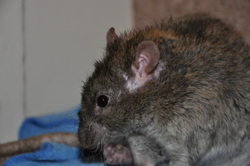
Odin, a peaceful gamma rat
These are rats that typically have little desire to be dominant rats, they are well liked by all in the cage and occupy the position that gels much of the group together. They are normally very submissive to there humans and their ratty cage mates and spend much of there time grooming each other and their cage mates. There is also often a informal hierarchy within gamma rats but this is rarely easy to place and more flexible, for instance one rat may end up with more food than another ‘gamma rat’ whereas that rat may get the better sleeping positions. Gamma rats rarely ever become aggressive though they may be subjected to bullying or slide down to zeta status when singled out by an alpha or beta. A neutered rat will normally fall into this category once their hormones have settled down, unless there are no other alphas or betas present.
Zeta rats
These rats are generally those at the bottom of the pile, but more than this they are often outcasts to a certain extent. In our pet colonies we very rarely see this in it’s extreme form however in the wild these rats are often isolated from companionship and seem to give up and die without a cause. In our pet colonies it is generally seen in a much milder form, with a rat actively avoiding certain rats in the group, mainly the alpha and beta rats. They will still spend time with other rats but should one of the more dominant rats appear, particularly one who has chosen to bully them, they will leave and sleep elsewhere. They can also be the victim of bullying activities, seemingly being chased around and excluded by an individual or group of dominant rats. This position can often be occupied by rats who don’t understand rat social signals so fail at communication. They could have been lone rats in the past for a long period or been raised in tiny groups with little interaction from there mother. This slot can also be occupied by rats who just don’t understand there position in the group, often young ‘teenage’ bucks or does who have the attitude but none of the brawn necessary to act on it. There refusal to send to right ‘submissive signals’ to the dominant rats can be as much or more of an issue than any excessive dominance by the aggressor. In some cases the Zeta rat is in this position through no fault of their own, for some reason it has been selected as the object of bullying or similar behaviour. This would mean looking to the aggressor to resolve the issue. It can also help to move zeta rats to other cage groups if that option is open to you, they may flourish in a different environment.
There is not always a Zeta rat in a cage, especially not in settled groups, however they can generally fail to thrive and do seem to be more susceptible to infections, though no doubt due to the better availability of food and human interaction they are not likely to give up in the same way there wild counterparts are. If a zeta rat is skinny, struggling to eat or drink or obviously distressed the experience it is worth attempting to step in. Short term food should be scatter fed at different levels in the cage (if you do not already do this) and multiple water bottles should be provided. To do this you should try and identify what I causing the behaviour, does the zeta rat display submissive behaviour, does it just avoid all confrontation and run. If it does it may be worth considering neutering the zeta rat
There is not always a Zeta rat in a cage, especially not in settled groups, however they can generally fail to thrive and do seem to be more susceptible to infections, though no doubt due to the better availability of food and human interaction they are not likely to give up in the same way there wild counterparts are. If a zeta rat is skinny, struggling to eat or drink or obviously distressed the experience it is worth attempting to step in. Short term food should be scatter fed at different levels in the cage (if you do not already do this) and multiple water bottles should be provided. To do this you should try and identify what I causing the behaviour, does the zeta rat display submissive behaviour, does it just avoid all confrontation and run. If it does it may be worth considering neutering the zeta rat
Group Grooming
The grooming of others is a very important part of rat society. As with most other social animals it’s used to maintain group bonds, show affection or dominance and get to know each other better. It also serves to help keep the group healthy, grooming places that the other rat can’t reach on its own and so ensuring the group as a whole doesn’t have a mass breakout of parasites. Rats will generally groom each other on the heads, shoulders or necks as these are the hardest to reach places for a lone rat. More aggressive grooming (to show dominance) will normally happen on the belly or flank and is usually coupled with some squeaks of protest from the groomed rat. This isn’t from pain as much as showing subservience and should not be interrupted unless true screams occur (see rat fight section later).
Rats will groom anything they consider part of their family, including humans and any other animals that they bond with. This can be very pleasant and is at least a boost to your self-esteem. It can sometimes be a little painful though, in the same way as repeatedly scratching the same place can become sore. Whilst rats have fur to protect them from nibbling teeth the humans impractical skin just isn’t designed for excessive grooming, however few rat owners can turn their rats down when they begin grooming them and normally it’s a pleasant experience for both rat and human. It’s particularly pleasant if you have a rat who likes to groom your head.
Rats will groom anything they consider part of their family, including humans and any other animals that they bond with. This can be very pleasant and is at least a boost to your self-esteem. It can sometimes be a little painful though, in the same way as repeatedly scratching the same place can become sore. Whilst rats have fur to protect them from nibbling teeth the humans impractical skin just isn’t designed for excessive grooming, however few rat owners can turn their rats down when they begin grooming them and normally it’s a pleasant experience for both rat and human. It’s particularly pleasant if you have a rat who likes to groom your head.
Dominance Grooming
This is a method for a rat to show dominance over other, it is generally initiated by a ‘pin’, the dominant rat will hold the other rat down, generally on its back, and begin manically grooming it’s belly, side or throat. The victim will normally let out little squeaks (pips) and struggle but eventually give in. After a short time the dominating rat will move on, often to groom themselves. This shouldn’t be mistaken for ‘forced grooming’. Dominance grooming can also be performed on a upright rat, in this situation the neck, shoulder and head are often groomed, this is markedly different to more social grooming as the victim is given little choice in the matter and grooming is often rough and done at a frenzied pace, rather than a slow careful approach. Rats resisting this activity may be bullied into submission via bites, kicks or pinning
Asking / Demanding to be Groomed
This is a specific behaviour by dominant rats in the hierarchy, they often are quite insistent that there inferiors groom them and use it as part of establishing themselves as top rat. There are a number of ways a rat will demand grooming from its cage mates, some are as follows; force grooming of the subordinate rat, then pausing to allow them to return the favour. Flipping on their back and sliding under the subordinate rat. Pulling the subordinate rats face with their paws, often whilst on the back. Sideling into the subordinate rat and then pausing, head lowered in a none aggressive but dominant manner. Some can grab a rats ‘cheeks’ and pull the rats mouth over their shoulders, some flip on their back and slide under the victim rat, again sometimes pulling that rats face to the part they want grooming. Some will sidle into their victim and potentially shove or kick them and continue to do it until the victim gives in and grooms them. Grooming is such an important part of ratty life that a rat that does not understand it is meant to groom others will often be harassed until it learns or it turns into outright bullying.
Forced grooming generally takes place from a dominant rat to a submissive, though generally rats who are at the top of the pack may turn to any rat and expect to be groomed when they wish. Normally there is one or two rats in a group who act as the main groomers for everyone else and are the targets for forced grooming attempts, these are generally highly social rats who are not necessarily at the bottom of the pack but are very secure in their position in it.
Forced grooming generally takes place from a dominant rat to a submissive, though generally rats who are at the top of the pack may turn to any rat and expect to be groomed when they wish. Normally there is one or two rats in a group who act as the main groomers for everyone else and are the targets for forced grooming attempts, these are generally highly social rats who are not necessarily at the bottom of the pack but are very secure in their position in it.
Other Social Behaviour
Bum Sniffing
A general greeting between rats is to sniff each other’s rear end. Generally speaking in rats that are comfortable around each other this is mild and short. In unfamiliar rats the dominant rat may actively grab it’s victim and have a proper sniff, flipping them or the victim rolling onto it’s belly makes this easier and will generally involve the rat sniffing deeply at the victims genitals. It is the rats version of finding out about the other rat. The scent carried in the urine communicates the rats sex, age, maturity, social position and how healthy they are. A rat may occasionally lick a tiny amount of urine up too to better judge the newcomer.
Marking
Marking is the leaving of small droplets of a special kind of urine as they walk. This isn’t true urination, whilst it uses urine as a carrier it is packed full of chemicals which carry information about the rats physical status. It is used to carry information to other rats about the sex, health, fitness and potential as a mate or competitor. When a rat smells another rats marking it sniffs in a particularly deep way, this is designed to focus the smell to a specific part of the rat’s nose which specialises in interpreting this information.
Rats will mark to a varying degree depending on their social status, typically more dominant rats or those who would like to be tend to mark more. Males also mark more than females. Rats will mark anything and often everything but particularly like marking things that hold the smell well (shiny surfaces are good for this, as are mobile phones and remote controls), new territory (anything you’ve recently cleaned and the vets table) and places that smell strongly of something else they want to overwhelm (e.g. places other rats have been and marked or human skin). Immediately cleaning up after a rat has marked often has the effect of making them mark more, so if it bothers you wearing a “rat jumper” and using a “rat blanket” to cover clothes and surfaces can help reduce the amount of marking that occurs
Rats will mark to a varying degree depending on their social status, typically more dominant rats or those who would like to be tend to mark more. Males also mark more than females. Rats will mark anything and often everything but particularly like marking things that hold the smell well (shiny surfaces are good for this, as are mobile phones and remote controls), new territory (anything you’ve recently cleaned and the vets table) and places that smell strongly of something else they want to overwhelm (e.g. places other rats have been and marked or human skin). Immediately cleaning up after a rat has marked often has the effect of making them mark more, so if it bothers you wearing a “rat jumper” and using a “rat blanket” to cover clothes and surfaces can help reduce the amount of marking that occurs
Rat Fighting, Aggression and Dominant Behaviour
Rats do occasionally fight amongst themselves, both in play and more seriously. This topic is large enough I've given it a separate page to itself which can be found here.
This also includes information on differentiating between aggressive / dominant etc behaviours
This also includes information on differentiating between aggressive / dominant etc behaviours
Submissive Behaviour
Submissive Rolling
A submissive rat will often roll over onto it’s back displaying it’s belly to the air (or the dominant rat) in response to even very minor dominance behaviour. The more submissive the rat generally the faster they will be to roll over. This behaviour generally placates the dominant rat before any more serious dominating behaviour can occur. It is also more common in kittens and young rats who roll over to more senior rats as a matter of course. Problems can occur when a rat rolls over submissively when the dominating rat really wants grooming. This can lead to some confusion as the dominating rat attempts to communicate it’s wants to the submissive rat and it’s only response is to become more pliant and submissive, letting out ‘peeps’ in protest and confusion.
Lowered head and body
A submissive rat or a rat that wishes to avoid instigating a fight will often approach a dominant rat with their head slightly lowered, they may turn their nose slightly away from the other rat too. They also normally carry their body close to the ground making their movement appear creeping and hesitant. This behaviour is often seen in rats approaching a dominant rat with something they want (such as food) or when requesting to be groomed (as opposed to demanding). The idea behind this is to encourage the dominant rat not to attack or leave the area by appearing as small as possible. This should not be confused with sidling or an aggressive posture where the head will be lowered but facing the victim, teeth often bared, fur erect and body turned sideways aimed at appearing as big as possible.
